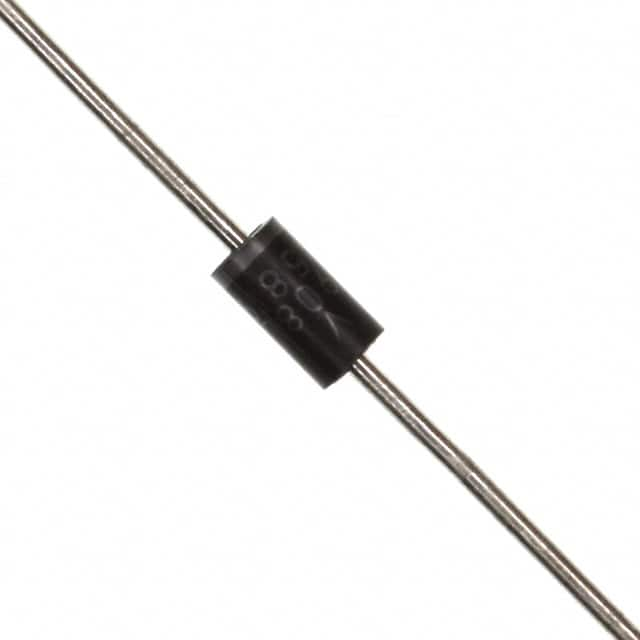1N5817 Diode
Product Overview
Category:
The 1N5817 diode belongs to the category of Schottky diodes.
Use:
It is commonly used in various electronic circuits for rectification and voltage regulation.
Characteristics:
- Low forward voltage drop
- High current capability
- Fast switching speed
Package:
The 1N5817 diode is typically available in a DO-41 package.
Essence:
This diode is essential for preventing reverse current flow and providing efficient rectification in electronic circuits.
Packaging/Quantity:
It is usually packaged in reels or tubes, with quantities varying based on manufacturer specifications.
Specifications
- Maximum Average Forward Current: 1A
- Maximum Reverse Voltage: 20V
- Forward Voltage Drop: 0.45V at 1A
- Operating Temperature Range: -65°C to 125°C
Detailed Pin Configuration
The 1N5817 diode has two pins, anode, and cathode. The anode is connected to the positive terminal, while the cathode is connected to the negative terminal.
Functional Features
- Efficient rectification of AC to DC
- Low forward voltage drop minimizes power loss
- Fast switching speed allows for rapid response in circuits
Advantages
- Low forward voltage drop reduces power dissipation
- Fast switching speed enables high-frequency applications
- Compact size and easy integration into circuit designs
Disadvantages
- Limited maximum reverse voltage compared to other diode types
- Sensitive to temperature variations
Working Principles
The 1N5817 diode operates based on the Schottky barrier principle, where the metal-semiconductor junction creates a low forward voltage drop and fast switching characteristics.
Detailed Application Field Plans
Power Supplies:
Used in power supply circuits for rectification and voltage regulation due to its low forward voltage drop and high current capability.
Solar Panels:
Applied in solar panel systems to prevent reverse current flow and improve overall efficiency.
LED Lighting:
Utilized in LED lighting circuits for rectification and current control, benefiting from its fast switching speed.
Detailed and Complete Alternative Models
- 1N5818: Higher maximum reverse voltage
- 1N5819: Lower forward voltage drop
- SS14: Similar characteristics with a different package type
In conclusion, the 1N5817 diode is a versatile component widely used in electronic circuits for its efficient rectification, low forward voltage drop, and fast switching speed. While it has limitations in terms of maximum reverse voltage and temperature sensitivity, its advantages make it a popular choice in various applications such as power supplies, solar panels, and LED lighting.
[Word Count: 398]
Senaraikan 10 soalan dan jawapan biasa yang berkaitan dengan aplikasi 1N5817 dalam penyelesaian teknikal
Sure, here are 10 common questions and answers related to the application of 1N5817 diode in technical solutions:
What is the 1N5817 diode used for?
- The 1N5817 diode is commonly used as a Schottky diode for rectification and voltage clamping applications.
What is the maximum forward voltage drop of the 1N5817 diode?
- The maximum forward voltage drop of the 1N5817 diode is typically around 0.45 volts at a forward current of 1 ampere.
What is the reverse voltage rating of the 1N5817 diode?
- The 1N5817 diode has a reverse voltage rating of 20 volts.
Can the 1N5817 diode handle high-frequency applications?
- Yes, the 1N5817 diode is suitable for high-frequency applications due to its fast switching characteristics.
Is the 1N5817 diode suitable for use in power supply circuits?
- Yes, the 1N5817 diode is commonly used in power supply circuits for rectification and voltage regulation.
What is the maximum average forward current rating of the 1N5817 diode?
- The maximum average forward current rating of the 1N5817 diode is typically around 1 ampere.
Can the 1N5817 diode be used in reverse polarity protection circuits?
- Yes, the 1N5817 diode is often used in reverse polarity protection circuits due to its low forward voltage drop and fast response time.
What is the temperature range for the 1N5817 diode?
- The 1N5817 diode is typically rated for operation within a temperature range of -65°C to 125°C.
Does the 1N5817 diode require a heat sink for high-power applications?
- For high-power applications, it is recommended to use a heat sink with the 1N5817 diode to dissipate heat effectively.
Are there any specific layout considerations when using the 1N5817 diode in a circuit?
- It is important to minimize the length of the traces between the 1N5817 diode and other components to reduce parasitic inductance and ensure proper performance.
I hope these questions and answers provide the information you were looking for! If you have any more questions, feel free to ask.


